Nailed Wood with Hardware NWH
A National Cigar Museum Exhibit
© Tony Hyman
Updated 03-18-19

Nailed Wood with Hardware NWH
A National Cigar Museum Exhibit
© Tony Hyman
Updated 03-18-19
It was difficult to print complex pictures on wood, so ad copy was often a few simple words in a decorative border. Some box makers mastered using red and gold to make dramatic boxes. Others used a mix of red, gold and silver inks with die cuts, inners or photographs.
NWH boxes experienced their Golden Age of design between 1880 and 1910. By the time of World War One, only a handful of companies were packing in this once popular box style. NWH boxes were driven out of the market by the increased cost of good looking fine grained box wood. This occurred at about the same time that tin cans and box trim became available cheaper than ever before. NWH boxes from after WWI are usually quite plain and marked by lesser quality wood, finish, and design.
[8395] [4275]
Fancy NWH boxes
Cute die cut of rural relative. Cigar brands named after uncles abounded. UNCLE CY, UNCLE DUDLEY, UNCLE JAKE, UNCLE JOE, three different UNCLE JOSH and, of course, UNCLE SAM are in the collection with many more relatives to be discovered. UNCLE DAN was made in Fact. 235 in the 9th District of PA shortly after 1900.
[04235]
Detailed die-cut as top brand, but not repeated inside. Bondy & Lederer’s factory at 70th Street & 1st Ave, in NYC, made the cigars for Lewis & Levy in Memphis. Marked as “Pat’d ‘86” but what’s patented is anyone’s guess. Rich coloring of the wood is unusual on an NWH box. Factory 294, 3rd (tax) Dist. NYC, employed 600 rollers.
[04211]
Box is marked as “patented November 6th 188[3,8,9?]” though what exactly is being patented isn’t clear. Printed in gold, red and black with die-cut photo inserted.
Cigars made by M.W. Mendel & Bro. in their huge 400 roller factory at 15½ Bowery in Manhattan (Fact. 729, 3rd NYC) for J.K. Sweeney Co. in Clinton Iowa in the early 1890’s. Collectors and dealers are often confused, believing names like Sweeney’s which are prominently displayed identify the maker. That’s usually not the case.
[02564]
Selection of Die-Cuts
Small brown jug applied, then overprinted in gold on an NWH 50/10 in 1898. Cigars by Barlow, Rogers & Simpson, a 60 person factory in the cigar center of Binghamton, NY (Factory 641, 21st NY).
[4247]
[8391] [8392]
Gold printing
Fine lines on wood and paper
Combination of black, gilt printing and round die-cut makes a NWHC 50/13 package that would stand-out in any cigar counter. Cigars made in Factory 159, 12th Dist. PA in mid 1880’s.
[04268]
[04209] [04210]
Black is beautiful
[04207] [04208]
Another classic, with color added
The classic NWH 100
Plain no nonsense bare bones basic box.
The classic NWH used by S. Lutz & Co., a 10 man factory located in Reading, PA. (Fact. 1179, 1st PA) in the early to mid 1880’s.
[04234]
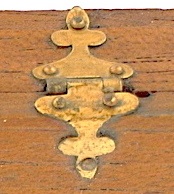
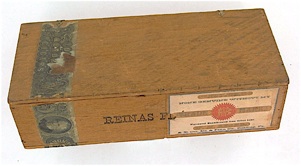
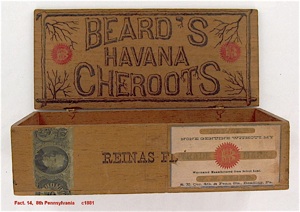

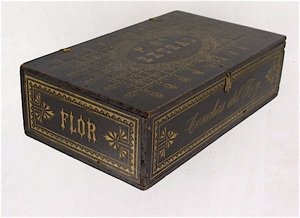

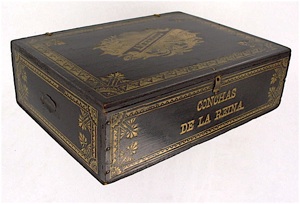

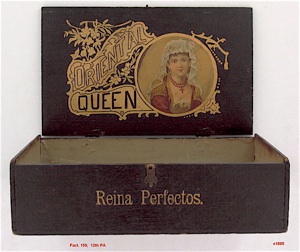
Varnished gilt and die-cut
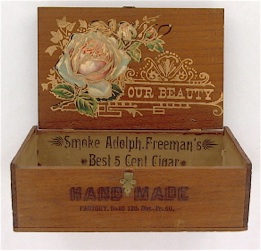

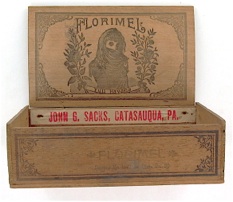

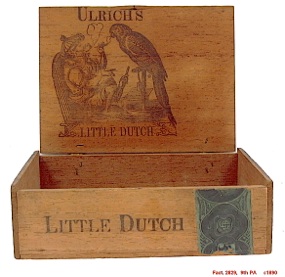

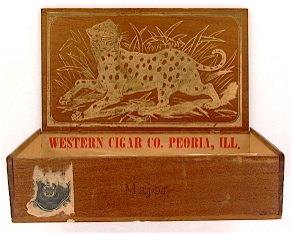
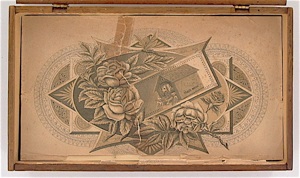
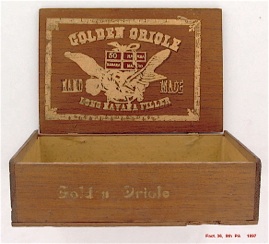
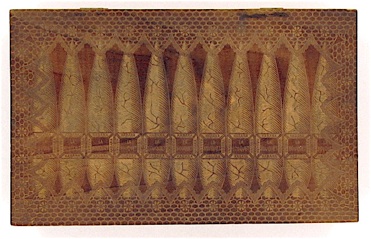
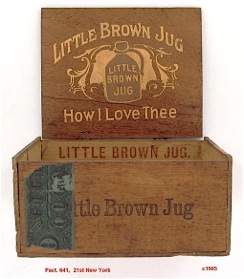

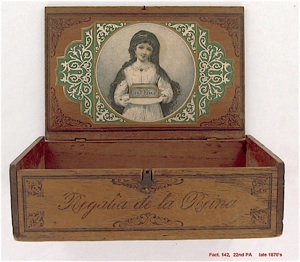
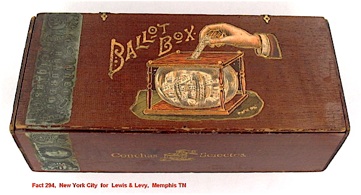
Designs that incorporate the stamp
Good example of how some top brands are offset to provide space for the stamp. Made in Factory 233, 2nd District of Wisconsin in 1909.
by far the most common. They’re fun to collect and read when on paper, but make a terrible
transition to wood. Dawn of the Twentieth Century, celebrating January 1st, 1901 is a great idea
but impossible to decipher the text in the various stories. Offset keeps the tax stamp from interfering with the illegible design, but the local Cigar Maker’s Union chapter screwed up their foresight. This seems to be a bad idea but a great box to own, certainly one of the rarest newspaper boxes.
Remember the argument whether 2000 or 2001 was the first year of the new century? Apparently they had the same debate a century before as I’ve found cigar boxes celebrating both dates.
[8394]
My 1st NWHCT came with a story
Bill was 88 when he passed his precious souvenir on to a 14 year old cigar box collector who retains it to this day. Bill lived to be 105.
Cigars were made by Sidney J. Freeman & Co., 120 Cherry Street in Manhattan. Fact. 884, 3rd NYC, but Bill remembered buying it in St. Louis.
[4212]
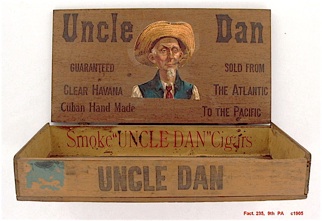
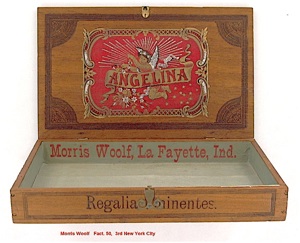
Paper label has a gilt frame overprinted. Cigars made in Wisconsin shortly after 1900.
[0835] [0836]
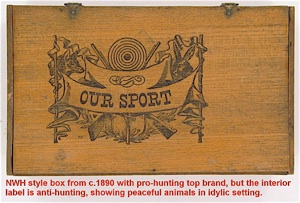


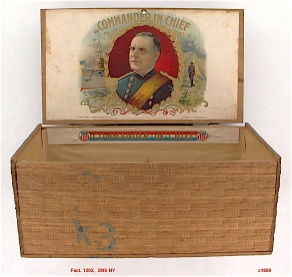
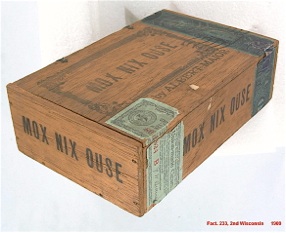


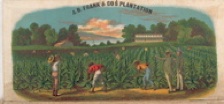

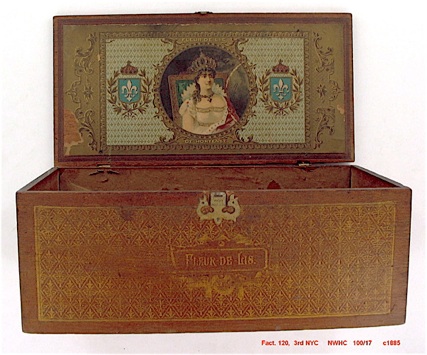
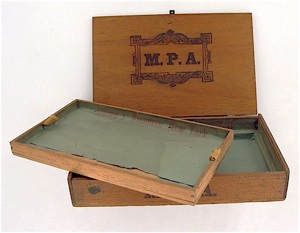
Most NWH boxes are either plain wood or varnished. The varnished OUR BEAUTY with its applied die-cut is aptly named. Cigars made by Adolph Freeman’s five man factory (Fact. 99, 12th PA) in Wilkes Barre in the mid 1880’s. Die-cuts of flowers, children, and other topics are frequently found.
[4233]
Standard varnished NWHC 50/10 with intricate fine line design that doesn’t translate all that well to printing on wood. Fact.1413 in the 21st Dist. of NY was owned by Iola D. Rothensies in Walton around 1885 when this was made.
[4244]
Very intricate design to be printed on wood. Note the offset, repeated on the outside, which provided space for the revenue stamp to be applied without affecting the design. I’m surprised that more cigar folks didn’t take the stamp into consideration when designing boxes as they were a fact of life. Why offset on both sides? The folks assembling the boxes didn’t have to worry about which side went inside and which went outside...and no extra set-up fee.
Little Dutch is a type of tobacco grown primarily in Ohio. Cigars made in Fact. 2829, 9th PA, owned by Stephen F. Ulrich in Elizabethtown, PA, in 1893 and John E. Ulrich in 1905.
NWHC100/20 with a somewhat elaborate plantation scene featuring two overseers and four slaves is clear despite its detail. Box used by Charles E. Bowman of Hagerstown Fact. 1197 MD c1900.
Paper label version of the image is below.
This early (c1884) gilt eagle was printed atop a stock black ink frame. Virtually all detail is lost, becoming a silhouette. Cigars by Umbenhauer & Poorman in Factory 422, 1st PA in Reading.
Note the blue liner. Colored liners were used as design elements more often in NWH cigar boxes than
in standard trimmed NW boxes.
Printing in “gold” was logical for golden brand names. The boxes on the oriole’s back are printed in red, the third most popular color for printing on NWH boxes (after black and gold). Note the offset and tilt,
a quality control problem not uncommon on NWH boxes. Cigars by Henry Marks, Littlestown, PA (Fact. 361, 9th PA) sometime between 1898 and 1901.
This is the same image as on the lithographed label called FEARLESS.
One of the most beautiful examples of detailed gold printing is found on the outside top of a c1900 German box made to hold cigars by Erutsner & Schwarz in Dresden for Erstes Habanna Haus cigar store. Box is an NWH 50/13 overall lid.
It takes a printer of exceptional skill to do an image like this. Too, the die must have been very fresh as the detail is incredible.
Fancy black and green die-cut of a little girl offering a box of cigars fits nicely inside a stock frame printed in black. This attractive package stood out in an 1870’s cigar counter. GILT EDGE cigars were made in Fact 142, 22nd Dist. PA in the late 1870’s by an unknown maker. The NWHC 50/13 originally had a dark red liner.
[4231]
Red, black, silver and gold featuring a cherub! One more proof boxes don't have to be covered with paper to be attractive. Made by the 1,000 rollers in Lichtenstein Bros. Fact. 50, 3rd Dist. NY located at 38th St. and 1st Ave. in Manhattan.
[04229]
REINA HORTENSIA is packed in a NWHC 100/13 box covered with decorative gold design. Fewer than 5% of NWH boxes use inner trim type labels.
This lovely box was used around 1890 by Steinecke & Kerr, a 250 roller factory located at 20 7th Street in Manhattan (Fact. 120, 3rd NY).